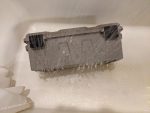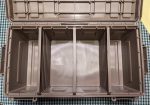

The new MTM Case-Gard ACDC30 Divided Ammo Crate is a sturdy, stackable, moisture-resistant solution for ammo storage and similar tasks. It provides as much ammo storage space as four standard .30 caliber ammo cans.
With a price at the time of this writing of $27.98 from www.mtmcase-gard.com, it was significantly less expensive than the $44.76 that four of MTM’s .30 caliber cans would cost (they currently run $11.19 each.)
Fully loaded, the ACDC30 would be a bit heavy for field use, but it provides an excellent solution for home ammo storage. I highly recommend it for that purpose.
The Backstory
I like MTM products. I have one of their pistol rests, a pistol case, a .50 caliber-sized ammo can, and two shotshell cases.
The shotshell cases are in a pattern that MTM no longer makes. I inherited them from my father, who purchased them almost 50 years ago now. Since MTM Case-Gard was started in 1968, that would make the shotshell cases one of the company’s earlier products. The cases have stood up well to the test of time, and continue to function well to this day.
Based on the good performance that I have experienced with my other MTM products, I was interested when I heard that they were releasing a new ammo crate. I asked MTM if they could provide a sample for testing and evaluation, and they were kind enough to agree. Two days later, the crate arrived from Dayton, Ohio via UPS ground.
First Impressions
The dark-earth-colored crate measures approximately 20x11x7.5 inches, outside dimensions. It has handles toward the top of each end, which is a clear acknowledgment that carrying the fully loaded crate will definitely be a two-handed job. The crate is made of high-impact polyethylene, and is rated for 75 pounds of storage. On the inside, three removable partitions can divide the inner space into four separate compartments. There are only three molded sets of rails on the inside of the crate to hold the dividers, so the choices are either “in” or “out” for each partition. If all three partitions are in, they divide the crate into four equally-sized compartments, each with the capacity of one .30 caliber ammo box.
An o-ring seal around the lid makes the crate water and moisture resistant. Two sturdy latches on the front of the lid with two padlock tabs on each latch fasten the lid securely.
One of the best things about the crate is that, like all other MTM products, it is made in these United States.
Testing
 I put a piece of paper toweling into each compartment of the crate to test for moisture, and closed the lid. I then set the crate on its side in the shower, turned on the cold water for several minutes and directed the spray onto the crate. After I turned off the water, I dried the outside of the crate and then opened it. I found the inside of the crate to be perfectly dry, with the paper toweling showing no signs of exposure to moisture.
I put a piece of paper toweling into each compartment of the crate to test for moisture, and closed the lid. I then set the crate on its side in the shower, turned on the cold water for several minutes and directed the spray onto the crate. After I turned off the water, I dried the outside of the crate and then opened it. I found the inside of the crate to be perfectly dry, with the paper toweling showing no signs of exposure to moisture.
Next, I moved all of my 7x57mm and 6.5x55mm ammo into the crate and stacked the crate on top of some other ammo cases. It stacked well. Moving the 7x57mm ammo also freed up a couple of ammo boxes for my .308 and .45 Colt ammo.
The essential qualities for ammo storage containers are that they protect their contents from impact damage and from moisture, and that they can be quickly and easily opened under field conditions without the use of tools. The ACDC30 Divided Ammo Crate seems to meet these criteria well.
The qualities of being quickly and easily opened without the use of tools reflect the lessons of Isandlwana and Roark’s Drift.
Isandlwana and Roark’s Drift
The Battle of Isandlwana on January 22, 1879 was the first major engagement of the Anglo-Zulu War. A force of 1,800 British troops, equipped with Martini-Henry breechloading rifles, was left to guard the British encampment. They were attacked by about 20,000 Zulu warriors equipped with thrusting spears. The British camp was not fortified, and the lids of their sturdy wooden ammo boxes were secured with screws.
Some say that difficulty opening the screwed-down lids of the ammo boxes eventually slowed the British rate of fire, allowing the encampment to be overrun. Others claim that the battle devolved into hand to hand combat too quickly for difficult access to ammo to become an issue. In any case, 1,300 British soldiers were killed during the course of the battle. For the remainder of the Anglo-Zulu war, the lids of ammo boxes were removed far in advance of any potential engagement.
While the British encampment at Isandlwana was being overrun, the British garrison at Roark’s Drift was making ready for battle. Roark’s Drift was a Church of Sweden Mission Station located just across a ford in the Buffalo River from the Zulu Kingdom. The British garrison consisted of only about 150 men. This garrison fortified their position with grain bags, opened their ammo boxes, and prepared for an attack.
A force of 3,000 to 4,000 Zulu warriors broke off from the forces around Isandlwana, and attacked the Roark’s Drift garrison. During the course of a twelve-hour battle, the British defenders managed to repel repeated Zulu attacks with the loss of 17 defenders. The Zulu attackers lost approximately 500 killed in the battle.
Of the 20,000 rounds of ammo that the British had available at the beginning of the attack, only 900 remained by the end of the battle.
The successful defense of Roark’s Drift against a vastly larger attacking force reinforced the importance of ready access to ammunition supplies. The battle is immortalized in the 1964 British film Zulu, starring Stanley Baker and Michael Caine.
Some Ammo Box History
If imitation is the sincerest form of flattery, then the M2A1 .50 Caliber Ammunition Can/Box/Chest, and the M19A1 .30 Caliber Ammunition Can/Box are the two most sincerely flattered ammo boxes in the United States today.
The M2A1 traces its lineage back to the aluminum M3 .50 Caliber Ammunition Chest that was adopted in 1934 for cavalry use. The M3 was a replacement for the wooden ammo boxes of the time. With the need to reserve aluminum for aircraft production at the start of World War II, the aluminum M3 was replaced by the riveted steel M17 .50 Caliber Ammunition Chest in March of 1942. The M17 was then quickly replaced, in turn, by the welded steel M2 .50 Caliber Ammunition Can/Box in September of 1942. The M2 was replaced in turn by the updated M2A1 in the 1950’s. The M2A1 is designed to hold 100 rounds of linked .50 caliber ammunition.
The lineage of the M19A1 is similar to that of the M2A1. It begins with the experimental aluminum T4 .30 Caliber Ammunition Chest, which was designed to replace wooden ammo boxes for use in vehicles. The steel M1 .30 Caliber Ammunition Can/Box replaced the T4 early in World War II. It was replaced by the improved M1A1 .30 Caliber Ammunition Can in June of 1945. The M1A1 was replaced in turn by the M19 .30 Caliber Ammunition Can/Box in 1946, designed to hold linked .30-06. Finally, the M19 was replaced by the M19A1 by 1954. The M19A1 was designed to hold 250 rounds of 7.62mm NATO ammunition.
Many (perhaps most) commercial ammo boxes are designed to mimic or reflect in some way the characteristics of either the M2A1 or the M19A1. Some of the characteristics of these two ammo boxes that are most often reflected in their imitators are capacity, dimensions, latch placement, and handle placement. The MTM Case-Gard ACDC30 is designed to mimic the capacity and internal dimensions of four M19A1 ammo boxes.
Rather than using ammo boxes, Russian and other Eastern Bloc armies preferred to seal their ammo into large “Spam” cans until ready for use. Although these cans were disposable rather than reusable, they seemed to do an excellent job of protecting their contents from moisture. They could, however, not be opened as quickly as M2A1 or M19A1 ammo boxes under field conditions.
Steel Versus Plastic
 The advantage of plastic ammo boxes is that they are corrosion-proof and generally less expensive than steel models. The advantage of steel ammo boxes is that they are more durable, especially when dropped while fully loaded on a hard surface under cold weather conditions. Steel cans fully loaded, can also be stacked to a much greater height without any deformation.
The advantage of plastic ammo boxes is that they are corrosion-proof and generally less expensive than steel models. The advantage of steel ammo boxes is that they are more durable, especially when dropped while fully loaded on a hard surface under cold weather conditions. Steel cans fully loaded, can also be stacked to a much greater height without any deformation.
Conclusions
The MTM Case-Gard ACDC30 Divided Ammo Crate provides a sturdy, stackable, moisture-resistant, and economical solution for ammo storage and similar purposes. Its volume is too large for practical ammo storage under field conditions, but it provides an excellent alternative for home storage. I highly recommend it.
Disclaimer
MTM Case-Gard provided me with a sample of their ACDC30 Divided Ammo Crate for testing and evaluation. I tried not to allow their kindness to influence my objectivity, and believe that I have succeeded. I did not receive any other financial or other inducement from any manufacturer, vendor, or supplier in return for mentioning them. This is a simple factual account of my own experiences: good, bad, or indifferent.

